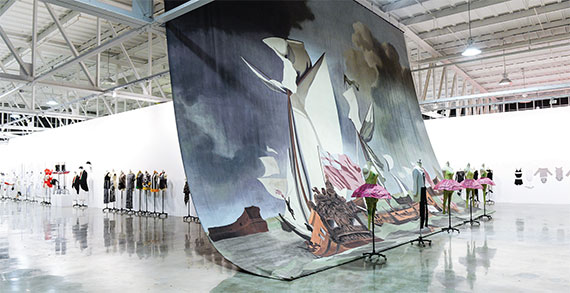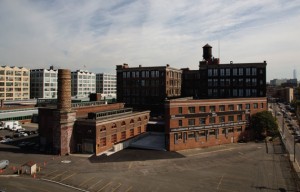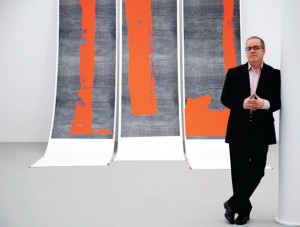Trending
Jersey City: The new Brooklyn?
An influx of artists is transforming the area into a creative scene that developers can brag about

A refurbished tobacco factory in Jersey City, now home to a sprawling arts complex called Mana Contemporary with studios, exhibition spaces and museum archives, is drawing crowds and undergoing an expansion.
In the nearby Journal Square neighborhood, the city is embarking on a $30-million renovation of the Landmark Loew’s Jersey Theatre. And a 110-year-old warehouse there is being converted into a luxury rental building with studio space and apartments set aside for working artists, one of many such buildings going up in the city.
“Our goal is to bring the creative class here,” said Jersey City Mayor Steve Fulop.
Welcome to what could be called “the new Brooklyn.” Young Wall Streeters have been moving to Jersey City’s waterfront high-rises in search of cheaper real estate and a quick commute to Manhattan for years. But as Brooklyn continues to gentrify, artists are now flocking to Jersey City too, scooping up studio space for some 30 percent less, and in many cases, they are taking up residence there altogether.
The influx, coupled with a flurry of new cultural venues and city initiatives like street performances and studio tours, has created a major arts community that is helping to revitalize a city once riddled with vacant lots and crime.
“Jersey City is the next place where everyone is going to be moving to,” said Ray Smith, an artist whose paintings are in the collections of the Metropolitan Museum of Art and the Whitney Museum of American Art.
Smith opened a 3,000-square-foot studio at Mana Contemporary two years ago, after Hurricane Sandy destroyed his workspace on the Gowanus Canal. He has since rebuilt in Brooklyn but plans to consolidate his operations in Jersey City in the next couple of years. He’s getting such a good deal that he declined to say how much he is paying.

Panoramic view of Mana Contemporary’s 2-million-square-foot campus in Jersey City. Photo by Adam Cohen.
Michael Bittel, a photographer and printer whose business, Eclectic Taste, prints art on textiles, wood and glass, moved from Greenpoint, Brooklyn to Jersey City in March. He pays a total of $1,300 a month for a renovated brownstone studio apartment in the desirable Paulus Hook neighborhood and an art studio in a warehouse on Pacific Avenue. In Brooklyn he paid $2,200 a month rent for a one-bedroom and had to work out of his apartment. His new home is a five-minute walk to the Grove Street PATH train station.
Bittel said the area is starting to feel like Brooklyn, with street fairs and restaurants catering to foodies. “I just went to Sam A.M., which uses locally sourced stuff and reminds me of my breakfast place in Greenpoint.”
Indeed, a number of Brooklyn establishments are opening outposts in the area. Word, a Greenpoint-based independent bookstore, opened a Jersey City branch in late 2013. Williamsburg-based Barcade opened a branch of its microbrewery/video arcade in Jersey City in 2011.
“The landscape is changing here by the minute,” said Marcia Langley a broker with Liberty Real Estate who has lived in Jersey City since 1995. “There’s an art scene in every corner of town now.”
The migration is already pushing up prices. Laura Skolar, owner of Century 21 Plaza Realty, says prices in the Jersey City Heights area are up nearly 20 percent this year over last. A year ago, one of her clients was going to list a two-family home in Jersey City Heights — a section of town with new zoning allowing artists to create live/work spaces
— for $325,000. But she ended up putting it on the market this past fall for $369,000. It received six offers and sold for $388,000.
Jersey City is improving so quickly that some artists are already fearful of being priced out. Stephen Cimini, a painter, bought a one-bedroom loft condo near Journal Square in 2009 for $250,000 with a parking space. He rents a studio across the street for $600 a month.
“Even in downtown Jersey City my apartment would cost double now,” Cimini said.

Mana Contemporary founder and executive director, Eugene Lemay, stands with his artwork, “Untitled, 2011.” Photo by Esther Montoro.
The city is making some efforts to keep the area affordable for artists. In order to win the contract to renovate the warehouse at 350 Warren Street, housing developer Mill Creek Residential had to include 13 artist studios, a 3,500-square-foot ground floor gallery and set aside 15 apartments for local artists who will receive subsidized rent.
The $150-million luxury rental building will have 366 units and is expected to open in October. “We are mixing the art community into the building,” said Rich Murphy, Mill Creek’s managing director for New Jersey. “We haven’t done this anywhere before.”
Though numerous factors are contributing to Jersey City’s growing status as an arts mecca, real estate developers consistently point to Mana Contemporary as a major catalyst.
The public art complex, which occupies more than 2 million square feet, is the brainchild of Moishe Mana, an Israeli-born businessman who is active in real estate and founded Moishe’s Moving and Storage, and his partner Eugene Lemay. The duo opened the complex in 2011 with an art storage business and 40 artist studios. In the first year they had a waiting list of 100 artists trying to get space.
Last year starchitect Richard Meier moved his models from Long Island City, Queens to a warehouse complex within Mana. His studio designed the space, which is now the Richard Meier Model Museum.
Currently in expansion mode, the Mana will have 400 studios, a program for galleries from abroad, five restaurants and a boutique hotel upon completion in 2016. Studios are rented at around $30 per square foot, which is similar to Brooklyn, according to Lemay. But Mana brings dealers to visit the artists, organizes exhibitions and creates a community.
In the blocks surrounding the complex, the sky is full of cranes as developers like the Kushners erect luxury apartment buildings.
“You can attribute that to Mana,” Lemay said. “They come here all day long and show bankers this artists’ colony.”




